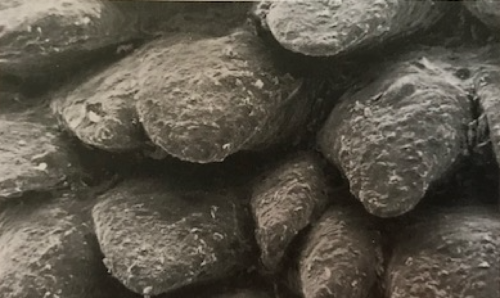
Anti-Fatigue floor mats have become de-rigueur in offices, kitchens, and work shops, but dogs don’t have the option of picking the surfaces on which they walk. Nature provided our dogs with heavily pigmented skin on their digital pads (torus digitalis, for you dog geeks) that happens to be the thickest region of their skin.
Ever notice how baby-bottom smooth the paws of a cat are? You won’t find that texture on the paws of an adult dog because of the presence of many conical projections that have heavily keratinized, unless……
…the dog is kept on a rough or concrete surface, and then the projections can be worn smooth so that they’re rounded instead of conical in shape. Paw pads also have a thick layer of fatty tissue that insulates the inner foot tissues from extreme temperatures, and that’s why your dog can walk in the snow “barefooted” while we would fall to our knees from frozen feet. That fatty tissue doesn’t conduct cold as quickly, plus arteries transfer the chilled blood back to the body where it warms up again. Scientists believe that because of these traits, domestic dogs most likely originally evolved in colder environments before migrating into other climates.
Lest you think that dog pads are pretty much the same for all breeds, au contraire! The mechanics of how they work may be similar among all breeds, but several standards address their breed’s pads with specificity. The Australian Cattle Dog’s standard calls for pads that are hard and deep, while the Aussie’s standard requires pads that are thick and resilient. The Cirneco dell’Etna should have pads that are same color as the nails which can be brown or flesh colored, while the Canaan Dog’s hard pads should have pigmentation that’s harmonious with its nose and eye rims. The Dutch Shepherd, however, should have pads that are elastic and dark, and the Maltese, Brussels Griffon, and Affenpinscher don’t just want dark pads, their standards calls for black pads. The Havanese standard is less exacting. The pads and nails can be any color.
The Silky Terrier should have “springy” pads, while the Puli should stand well up on his pads, most probably to better plan a bit of larceny. Just saying. A Bedlington Terrier should have smooth pads, but the Irish Terrier standard goes further by indicating that the pads should be deep, and must be perfectly sound and free from corns. Cracks alone do not necessarily indicate unsound feet. In fact, all breeds have cracked pads occasionally, from various causes. Someone alert the Kerry Blue Terrier, it’s standard reads, ” good depth of pad free free from cracks.” An Entlebucher Mountain Dog’s pads should be “robust,” and a Finnish Lapphund’s pads should be “elastic.”
Suffice it to say that breed standards tend to be specific about the pads in their breeds. Do you know what your breed’s standard allows?
Image of a scanning electron micrograph of conical projections on the surface of a dog’s pad

The Norwich Terrier standard calls for “thick pads,” which are appropriate on those occasions when they dig, but also for traversing all types of different surfaces, some with potential hazards, in search of quarry.
Makes complete sense! Thanks for sharing, Sally!